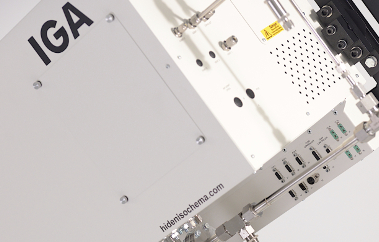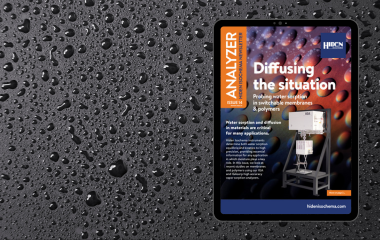In the Journal of the American Chemical Society, Stylianou et al have reported on the investigation of the structural transformation of a Zn-based flexible
Latest ABR Breakthrough System Data
New data from our ABR breakthrough systems
We take a look at some of the new data from our ABR breakthrough systems for the analysis of adsorbents for CO2 capture, hydrocarbon separation and nuclear fuel reprocessing technology.
This year has seen the publication of yet more data measured using our breakthrough analyzers and a corresponding rise in the level of interest in these systems.
The Hiden Isochema ABR series allows the measurement of breakthrough curves, which are plots of the composition, as a function of time, of the outlet stream from a fixed sorbent bed following an applied step change in the inlet composition. For a single component gas or vapor (in an inert carrier), the breakthrough time will be dependent upon the adsorption capacity of the adsorbent bed. Breakthrough curves with multicomponent mixtures, meanwhile, can be used to study competitive adsorption processes and to determine the ability of a given sorbent to separate different gas or vapor species.
One such system is installed in the group of Dr Praveen Thallapally at Pacific Northwest National Laboratory (PNNL) in the US. Dr Thallapally’s group has been publishing data measured on their system since 2012. Further details can be found in two papers from that year [1,2].
The first of these [1] used breakthrough curves to determine the ability of two metal-organic frameworks (MOFs) – containing coordinatively unsaturated metal centers – and an activated carbon to separate low concentrations of xenon (Xe) and krypton (Kr) from air for nuclear fuel reprocessing applications (see ref. [3] for further information on this interesting application). Breakthrough curves were measured for pelletized Ni/DOBDC and HKUST-1 with mixtures of Kr/Xe, Kr/Xe/He, Xe/air, Kr/air and ternary mixtures of Xe, Kr and air [1]. The second paper, on the other hand, examined the ability of Ni/DOBDC to capture CO2 from both wet and dry simulated flue gas (CO2/N2) [2].
The most recent work performed on ABR breakthrough systems was published this year in Nature Materials [4] and Nature Chemistry [5]. The first of these two examples studied noble gas separation using a novel organic cage molecule known as CC3 [6]. In this case, the ABR was used to measure breakthrough curves under conditions of particular relevance to nuclear fuel reprocessing applications, with 400 ppm of Xe and 40 ppm of Kr in air. Data for Ni-MOF-74 were also reported for comparative purposes.
In the other report from this year [5], Professor Martin Schröder’s group at the University of Nottingham in the UK and his collaborators at Oak Ridge National Laboratory (ORNL) in the US and the Diamond Light Source near Oxford, studied the binding of acetylene (C2H2), ethylene (C2H4) and ethane (C2H6) in the metal-organic framework NOTT-300 using a range of techniques, including neutron and synchrotron X-ray diffraction, and inelastic and quasi-elastic neutron scattering. To complement this work, they measured equilibrium single and dual component adsorption isotherms using an IGA, but also breakthrough curves for equimolar mixtures of C2H2/C2H4 in order to demonstrate the ability of NOTT-300 to selectively adsorb acetylene over ethylene. In addition, the methane adsorption capacity was also measured and found to be low. As the authors note, the separation of the four species examined in this study is of interest for a number of applications, including the purification of ethylene, olefin/paraffin separation and natural gas upgrading.
These studies provide an excellent illustration of the range of potential applications for both new adsorbents and our sorption analysis instrumentation. Furthermore, they demonstrate the complementarity of breakthrough curve measurement when studying materials for use in gas and vapor separation and purification processes.
If you would like further information or would like to discuss your application requirements in more detail, please do not hesitate to contact us.
About the ABR Series
Hiden Analytical mass spectrometers have long been used for the analysis of gas composition in flowing breakthrough systems, but the Hiden Isochema ABR Series offers this functionality in a fully integrated system, in which the mass spectrometer is controlled by the same software as the gas or vapor delivery module. Such fully integrated software and instrument control for gas and vapor breakthrough analysis is not currently available from any other commercial supplier.
References
[1] J. Liu, P. K. Thallapally and D. Strachan (2012) Metal-organic frameworks for removal of Xe and Kr from nuclear fuel reprocessing plants, Langmuir 28, p. 11584-11589
[2] J. Liu, P. K. Thallapally and B. P. McGrail (2012) Selective CO2 capture from flue gas using metal-organic frameworks – a fixed bed study, Journal of Physical Chemistry C 116, p. 9575-9581
[3] D. Banerjee, A. J. Cairns, J. Liu, R. K. Motkuri, S. K. Nune, C. A. Fernandez, R. Krishna, D. M. Strachan and P. K. Thallapally (2014) Potential of metal-organic frameworks for separation of xenon and krypton, Accounts of Chemical Research DOI: 10.1021/ar5003126
[4] L. Chen, P. S. Reiss, S. Y. Chong, D. Holden, K. E. Jelfs, T. Hasell, M. A. Little, A. Kewley, M. E. Briggs, A. Stephenson, K. M. Thomas, J. A. Armstrong, J. Bell, J. Busto, R. Noel, J. Liu, D. M. Strachan, P. K. Thallapally and A. I. Cooper (2014) Separation of rare gases and chiral molecules by selective binding in porous organic cages, Nature Materials 13, p. 954-960
[5] S. Yang, A. J. Ramirez-Cuesta, R. Newby, V. Garcia-Sakai, P. Manuel, S. K. Callear, S. I. Campbell, C. C. Tang and M. Schröder (2014) Supramolecular binding and separation of hydrocarbons within a functionalized porous metal-organic framework, Nature Chemistry DOI: 10.1038/nchem.2114
[6] T. Tozawa, J. T. A. Jones, S. I. Swamy, S. Jiang, D. J. Adams, S. Shakespeare, R. Clowes, D. Bradshaw, T. Hasell, S. Y. Chong, C. Tang, S. Thompson, J. Parker, A. Trewin, J. Bacsa, A. M. Z. Slawin, A. Steiner and A. I. Cooper (2009) Porous organic cages, Nature Materials 8, p. 973-978


